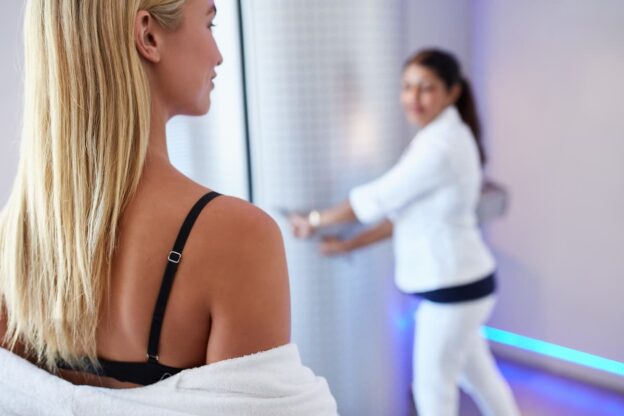Welcome to “The Chilling World of Cryotherapy,” a comprehensive exploration of one of the most intriguing and rapidly growing fields in health and wellness. In this book, we will delve deep into the fascinating realm of cryotherapy, uncovering its origins, scientific principles, diverse applications, and the myriad benefits it offers to individuals from all walks of life.
Cryotherapy, which involves exposing the body to extremely cold temperatures for therapeutic purposes, has captured the attention of scientists, athletes, beauty enthusiasts, and health-conscious individuals around the globe. It promises a wide range of advantages, from reducing pain and inflammation to improving athletic performance, enhancing mental well-being, and even aiding in weight loss.
In the following chapters, we will embark on an exciting journey through the icy landscapes of cryotherapy. We will examine the science behind this chilling therapy, explore its historical roots, and discuss the various forms it takes, from ice baths to cutting-edge cryo chambers. You will gain insight into the many ways cryotherapy is transforming lives, from speeding up recovery for athletes to providing relief for chronic pain sufferers.
However, it’s not all frosty bliss. We will also uncover the potential risks and precautions associated with cryotherapy, ensuring that you have all the information needed to make informed decisions about your cold therapy journey.
Furthermore, we will venture into uncharted territory, exploring emerging trends and innovations in the world of cryotherapy, including at-home techniques and the latest research findings.
To complete our exploration, we’ll hear from real people who have experienced the transformative effects of cryotherapy firsthand, sharing their inspiring stories and testimonials.
So, buckle up, as we embark on this exhilarating journey through the world of cryotherapy. Whether you’re a seasoned cold enthusiast or just beginning to dip your toes into the icy waters of this field, “The Chilling World of Cryotherapy” promises to be an informative and entertaining companion on your quest for better health and well-being.
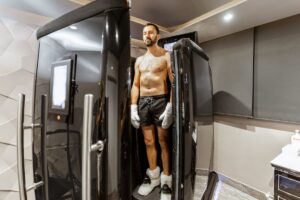
Chapter 1: The Science Behind Cryotherapy
In the quest for optimal health and well-being, humanity has often turned to nature’s elements for answers. From ancient traditions of hydrotherapy to the modern-day fascination with cryotherapy, our relationship with temperature extremes as a form of therapy has deep roots. In this chapter, we’ll delve into the science that underpins cryotherapy, revealing how exposing the body to cold temperatures can trigger remarkable physiological responses.
The Therapeutic Chill
Cryotherapy, derived from the Greek words “kryos” (cold) and “therapeia” (healing), is the practice of subjecting the body to extremely cold temperatures for therapeutic purposes. This intriguing therapy harnesses the power of cold to stimulate the body’s natural healing mechanisms.
When the body is exposed to cold, an immediate response occurs – vasoconstriction. Blood vessels narrow to conserve heat and redirect blood flow away from the extremities and towards vital organs. This natural reaction serves as a protective mechanism and is the initial step in the cryotherapy process.
The Release of Endorphins
As the body continues to endure the cold, a more profound response takes place. The brain signals the release of endorphins, often referred to as “feel-good” hormones. Endorphins not only contribute to pain management but also enhance one’s sense of well-being and reduce stress and anxiety. It’s this natural high that many cryotherapy enthusiasts find addictive and uplifting.
Norepinephrine and Cognitive Benefits
Norepinephrine, another key player in the cryotherapy process, is a hormone and neurotransmitter. Cold exposure prompts the release of norepinephrine, which plays a vital role in cognitive function and mood regulation. The result is increased alertness, improved concentration, and an uplifted mood. For those seeking mental clarity and improved mental health, cryotherapy offers a unique path.
Boosting the Immune System
Beyond mood enhancement and pain relief, cryotherapy also has a remarkable impact on the immune system. The cold exposure triggers the production of white blood cells, the soldiers of our immune system. This strengthened immune response can help individuals ward off illnesses more effectively, making cryotherapy not just about feeling better but also staying healthier.
Balancing Act: Risks and Rewards
While the science behind cryotherapy is fascinating, it’s essential to acknowledge that this therapy isn’t without its risks and limitations. In subsequent chapters, we will explore these aspects in detail, providing a balanced perspective on cryotherapy’s potential benefits and challenges.
As we journey deeper into the world of cryotherapy in the coming chapters, we’ll uncover its historical roots, diverse applications, and real-world impact on individuals striving for improved health and well-being. From athletes seeking faster recovery to those living with chronic pain conditions, cryotherapy has the potential to offer a chill that heals.
So, join me as we embark on an exhilarating exploration of the world of cryotherapy. Whether you’re already a cold therapy enthusiast or just curious about its possibilities, this journey promises to be both informative and enlightening. Together, we’ll uncover the secrets behind the transformative power of the icy embrace in “The Chilling World of Cryotherapy.”

Chapter 2: A Brief History of Cold Therapy
To truly understand the significance of cryotherapy in the modern era, it’s essential to take a step back in time and explore the roots of cold therapy throughout history. From ancient civilizations to more recent innovations, the use of cold for therapeutic purposes has a rich and diverse history.
Ancient Beginnings
The practice of using cold as a form of therapy can be traced back thousands of years. Ancient civilizations, such as the Egyptians, Greeks, and Romans, recognized the healing properties of cold water and ice. In these early societies, cold baths and ice packs were used to treat a range of ailments, from pain and inflammation to fevers and injuries.
The Ice Age: 18th and 19th Centuries
The use of cold therapy experienced a resurgence during the 18th and 19th centuries. This era saw the emergence of “hydropathy” or the “water cure” movement, which advocated for the use of cold water treatments, including cold baths, showers, and compresses, to promote health and well-being. One notable figure in this movement was Vincent Priessnitz, an Austrian farmer who gained fame for his hydrotherapy practices.
Ice Baths and Cold Plunges
The 19th century also witnessed the popularity of cold baths and cold plunges, particularly in Europe. In countries like Russia and Finland, the tradition of winter swimming in icy lakes and rivers became a cultural practice. This extreme exposure to cold was believed to boost immunity, improve circulation, and invigorate the body and mind. Today, “polar bear plunges” and cold-water swimming events continue in various parts of the world.
The Birth of Modern Cryotherapy
While the historical use of cold therapy laid the foundation, it wasn’t until the mid-20th century that modern cryotherapy as we know it began to take shape. Dr. Yamaguchi of Japan is often credited with pioneering the concept of whole-body cryotherapy in the 1970s. He developed the first cryo chamber, which exposed patients to extremely cold air for short durations to relieve pain and inflammation associated with conditions like rheumatoid arthritis.
Cryotherapy Goes Mainstream
The concept of cryotherapy gained more widespread recognition and acceptance in the 21st century. Initially, it was embraced primarily by elite athletes seeking faster recovery. Whole-body cryotherapy chambers began to appear in sports facilities and wellness centers worldwide.
The Power of Celebrity Endorsement
One factor that contributed significantly to the popularity of cryotherapy was celebrity endorsements. High-profile athletes and celebrities, including LeBron James and Cristiano Ronaldo, publicly praised the benefits of cryotherapy, bringing it to the attention of a broader audience. Their testimonials and experiences fueled curiosity and interest in the therapy.
Scientific Validation
In parallel with its rising popularity, cryotherapy has garnered attention from the scientific community. Researchers have conducted studies to explore the physiological effects of cold therapy. These studies have supported claims of reduced inflammation, improved pain management, and enhanced recovery.
Conclusion
The history of cold therapy is a fascinating journey that spans ancient civilizations, revival movements, and modern innovations. From the earliest ice baths to the high-tech cryo chambers of today, cold therapy has evolved significantly. It has transitioned from a niche practice to a mainstream wellness trend with a growing body of scientific evidence supporting its benefits.
In the next chapter, we will delve deeper into the various forms of cryotherapy, from ice baths to localized cryo treatments. Understanding the different modalities will provide insight into the versatility of cold therapy and how it can be tailored to individual needs and preferences.
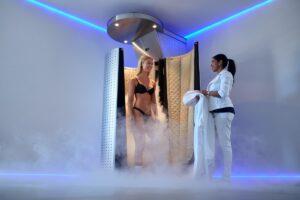
Chapter 3: Types of Cryotherapy: From Ice Baths to Cryo Chambers
Cryotherapy is not a one-size-fits-all treatment; rather, it encompasses a variety of techniques and methods, each tailored to specific needs and preferences. In this chapter, we’ll explore the diverse landscape of cryotherapy, from traditional ice baths to cutting-edge cryo chambers, revealing the different modalities available for those seeking the benefits of cold therapy.
1. Ice Baths: Ancient Wisdom in a Tub
One of the earliest forms of cryotherapy, ice baths, dates back to ancient civilizations. The concept is simple: immerse the body in a tub filled with cold water and ice. Ice baths are known for their ability to reduce inflammation, soothe sore muscles, and promote a sense of rejuvenation. Athletes have relied on this traditional method for decades, especially after intense workouts or competitions.
2. Cold Compressions: Targeted Relief
For localized cryotherapy, cold compressions are a popular choice. This method involves applying cold packs or compresses directly to specific areas of the body, such as joints or muscles. Cold compressions are effective for acute injuries, sprains, and strains, as they provide targeted relief and help reduce swelling and pain.
3. Cryo Chambers: The Modern Marvel
One of the most recognized and advanced forms of cryotherapy is the cryo chamber, also known as a cryosauna. This innovation takes cold therapy to a whole new level. In a cryo chamber, individuals step into a specially designed enclosure that exposes them to extremely cold air, typically around -110°C (-166°F) for a brief period, usually 2-3 minutes.
The extreme cold triggers the body’s natural physiological responses, such as vasoconstriction, endorphin release, and enhanced circulation. Cryo chambers are renowned for their effectiveness in reducing muscle soreness, speeding up recovery, and promoting overall well-being. They have become a go-to choice for athletes and individuals seeking comprehensive cryotherapy sessions.
4. Cryotherapy Facials: Cool Beauty
Cold therapy isn’t limited to the body; it can also benefit the skin. Cryotherapy facials involve the use of a specialized wand or device that emits extremely cold air onto the face. This facial treatment is known for its ability to tighten the skin, reduce puffiness, and promote a youthful glow. Celebrities and beauty enthusiasts have popularized cryotherapy facials as a non-invasive, refreshing way to rejuvenate the skin.
5. Localized Cryo Treatments: Precision Cooling
Localized cryotherapy treatments target specific areas of the body, offering precise cooling where it’s needed most. These treatments often use a handheld device that emits a stream of cold air directly onto the targeted area. This approach is popular among athletes and individuals recovering from injuries, as it allows for focused relief.
6. Cryo Saunas: The Full-Body Experience
Cryo saunas, similar to cryo chambers, offer a full-body cold therapy experience. However, they often use different technology. Instead of stepping into an enclosed chamber, individuals enter a cabin-like sauna. Liquid nitrogen or cooled air is used to rapidly lower the temperature inside the cabin. Cryo saunas provide the same benefits as cryo chambers but in a slightly different setting, catering to personal preferences.
7. Cryotherapy Pads: Convenient Cold Therapy
For at-home cryotherapy, cryotherapy pads or wraps are a convenient choice. These are flexible pads that can be applied to various body parts and are often used for pain management and recovery. They can be kept in the freezer and used whenever needed, making them a practical option for individuals looking to incorporate cryotherapy into their daily routine.
Conclusion
The world of cryotherapy is diverse and adaptable, offering a range of options to suit individual preferences and therapeutic needs. From ancient ice baths to modern cryo chambers, each modality provides its own unique benefits. Whether you’re an athlete seeking enhanced recovery, someone dealing with chronic pain, or simply interested in the rejuvenating effects of cold therapy, there’s a cryotherapy method for you.
In the following chapters, we will dive deeper into the specific benefits and applications of these various cryotherapy techniques. Understanding the differences between them will empower you to make informed choices about which type of cryotherapy aligns best with your goals and lifestyle.
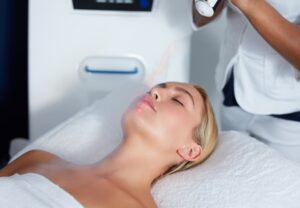
Chapter 4: Benefits of Cryotherapy: Healing and Beyond
Cryotherapy, with its diverse modalities ranging from ice baths to cryo chambers, has gained immense popularity in recent years. While it’s been embraced by athletes and wellness enthusiasts, its benefits extend far beyond muscle recovery. In this chapter, we will explore the wide-ranging advantages of cryotherapy, from healing and pain relief to enhancing overall well-being.
1. Accelerated Recovery
One of the primary reasons athletes and fitness enthusiasts turn to cryotherapy is its ability to accelerate recovery. After an intense workout or competition, muscles often suffer microtraumas and inflammation. Cryotherapy’s cold exposure helps reduce this inflammation and promotes faster healing. Athletes report feeling refreshed and ready for their next training session after a cryotherapy session.
2. Pain Management
Cryotherapy’s analgesic, or pain-relieving, effect is well-documented. The cold temperatures cause blood vessels to constrict, reducing blood flow to the affected area. This decrease in blood flow can help numb pain and reduce swelling. People with chronic pain conditions like arthritis, fibromyalgia, or back pain often turn to localized cryotherapy or whole-body cryo chambers for relief.
3. Reduced Inflammation
Inflammation is the body’s natural response to injury or illness. However, chronic inflammation can lead to various health problems. Cryotherapy is effective in reducing both acute and chronic inflammation. By constricting blood vessels and decreasing the production of pro-inflammatory cytokines, it helps bring inflammation under control, potentially benefiting conditions like rheumatoid arthritis.
4. Improved Skin Health
Cryotherapy isn’t just for muscles and joints; it can also benefit the skin. Cryotherapy facials are known for their ability to tighten the skin, reduce puffiness, and promote collagen production. The cold air stimulates blood flow, which can give your skin a healthy, youthful glow. Celebrities often turn to cryo facials to maintain their radiant appearances.
5. Mental Well-Being
The release of endorphins during and after cryotherapy sessions isn’t limited to just pain relief; it can also boost mood and mental well-being. Many individuals report feeling invigorated, less stressed, and more alert after cryotherapy. This natural high can be particularly beneficial for those dealing with stress, anxiety, or depression.
6. Enhanced Immune Function
Cryotherapy’s impact on the immune system is another noteworthy benefit. Exposure to cold temperatures prompts the body to produce more white blood cells, which are crucial for fighting infections. A strengthened immune system can help individuals ward off illnesses more effectively, contributing to overall health.
7. Weight Management
While not a substitute for a healthy diet and exercise, cryotherapy has been explored as a potential aid in weight management. The extreme cold temporarily increases metabolism, leading to the burning of more calories. Additionally, some individuals find that cryotherapy helps reduce food cravings and can be a valuable tool in their weight loss journey.
8. Enhanced Athletic Performance
Beyond recovery, cryotherapy can boost athletic performance. The reduction in muscle soreness and inflammation allows athletes to train more effectively and consistently. Some studies suggest that cryotherapy can enhance endurance and strength, potentially providing a competitive edge.
9. Better Sleep
Improved sleep is an often-overlooked benefit of cryotherapy. The relaxation and stress reduction associated with cryotherapy can lead to more restful sleep. Many individuals who incorporate cryotherapy into their routines report better sleep quality and overall sleep patterns.
10. Beauty and Anti-Aging
Cryotherapy’s effects on skin health go beyond the immediate benefits of facials. Some believe that regular exposure to cold temperatures can slow down the aging process by promoting collagen production and reducing the appearance of wrinkles. While more research is needed in this area, it’s an intriguing aspect of cryotherapy’s potential.
Conclusion
The benefits of cryotherapy are vast and extend into many aspects of health and well-being. Whether you’re an athlete seeking faster recovery, someone dealing with chronic pain, or simply looking to enhance your overall health, cryotherapy offers a multifaceted approach to well-being. As we delve further into this topic in the following chapters, we will explore specific applications and case studies that highlight the transformative potential of cryotherapy in various contexts.

Chapter 5: Cryotherapy and Athletes: Enhancing Performance
Athletes, whether professional or recreational, are always seeking an edge to improve their performance, speed up recovery, and stay competitive. Cryotherapy has emerged as a valuable tool in the world of sports and fitness, offering unique benefits that cater to the demands of athletes. In this chapter, we will explore how cryotherapy can enhance athletic performance and help individuals reach their peak potential.
1. Faster Recovery
One of the primary reasons athletes turn to cryotherapy is its ability to expedite the recovery process. After intense training sessions or competitions, muscles often endure microtraumas and inflammation. Cryotherapy’s cold exposure helps reduce this inflammation and promote faster healing. Athletes can return to training sooner and with reduced muscle soreness, allowing for more consistent and effective workouts.
2. Muscle and Joint Relief
Athletes frequently face muscle and joint discomfort due to the rigorous demands of their sports. Cryotherapy’s pain-relieving properties can offer significant relief. By constricting blood vessels and reducing inflammation, cryotherapy helps alleviate muscle soreness and joint pain. This allows athletes to maintain their training regimens with less interruption and discomfort.
3. Enhanced Athletic Performance
Cryotherapy’s impact on athletic performance extends beyond recovery. Studies have suggested that cryotherapy can enhance endurance and strength, potentially giving athletes a competitive advantage. The temporary increase in metabolism during and after cryotherapy sessions can lead to improved energy levels and stamina.
4. Reduced Risk of Injury
Preventing injuries is crucial for athletes, and cryotherapy can play a role in injury prevention. By regularly incorporating cryotherapy into their routines, athletes can maintain better joint and muscle health. This may reduce the risk of overuse injuries and enhance overall durability, allowing athletes to perform at their best over the long term.
5. Mental Resilience
Athletics is not just a physical endeavor; it’s also a mental challenge. Cryotherapy’s mood-enhancing effects, attributed to the release of endorphins, can help athletes stay mentally resilient and focused. Improved mood and reduced stress levels can be invaluable in high-pressure situations.
6. Competitive Edge
In the world of professional sports, where fractions of a second or minor advantages can make a significant difference, cryotherapy has become a part of many athletes’ training regimens. Having a tool that promotes recovery, reduces the risk of injury, and enhances performance can provide that extra competitive edge.
7. Team Integration
Cryotherapy has also found its place within sports teams and organizations. Many professional sports teams have cryotherapy chambers or localized cryotherapy equipment in their facilities. This accessibility allows athletes to incorporate cryotherapy seamlessly into their training routines, making it an integral part of their performance optimization strategies.
8. Post-Injury Rehabilitation
For athletes recovering from injuries, cryotherapy can be a crucial component of their rehabilitation programs. It helps reduce pain, inflammation, and muscle spasms, facilitating a quicker and more effective recovery process. Many athletes credit cryotherapy with aiding in their rehabilitation and helping them return to peak performance.
9. Versatility in Sports
Cryotherapy is not limited to specific sports; it is adaptable and beneficial across various athletic disciplines. Whether you’re a runner, weightlifter, swimmer, or team sports athlete, cryotherapy offers advantages that can apply to virtually any sport. This versatility has contributed to its widespread adoption in the athletic community.
Conclusion
Cryotherapy has earned its place as a valuable tool for athletes seeking to optimize their performance, enhance recovery, and reduce the risk of injuries. From professional athletes in elite sports to fitness enthusiasts in local gyms, the benefits of cryotherapy have become widely recognized. As we continue our exploration of cryotherapy in the following chapters, we will delve deeper into its applications in pain management, beauty and skin care, and mental well-being, providing a comprehensive understanding of its versatile potential.
Chapter 6: Cryotherapy for Pain Management: A Cold Comfort
Chronic pain affects millions of people worldwide, often leading to reduced quality of life and limited mobility. Traditional pain management approaches, such as medications or physical therapy, may not always provide adequate relief. Enter cryotherapy, an innovative and non-invasive method that offers a cold comfort for those seeking relief from various types of chronic pain.
1. Targeted Pain Relief
Localized cryotherapy treatments, which involve the application of cold to specific areas of the body, are particularly effective for targeted pain relief. This approach allows individuals to focus cold therapy precisely where they need it most, whether it’s on sore joints, muscle knots, or specific areas affected by chronic pain conditions.
2. Reducing Inflammation
Inflammation is a common source of chronic pain, and cryotherapy’s ability to reduce inflammation can be invaluable. Cold exposure constricts blood vessels, leading to decreased blood flow to the affected area. This reduction in blood flow can help numb pain and reduce swelling, providing much-needed relief.
3. Managing Arthritis
Arthritis, a common chronic pain condition, can be especially debilitating. Cryotherapy, including localized treatments and whole-body sessions, has shown promise in managing the pain and inflammation associated with arthritis. Many arthritis sufferers find that regular cryotherapy sessions help them maintain better joint function and experience less discomfort.
4. Fibromyalgia Relief
Fibromyalgia is characterized by widespread musculoskeletal pain and tenderness. Managing this condition can be challenging, but cryotherapy has offered hope to some individuals with fibromyalgia. The cold exposure can help alleviate muscle pain and reduce the hypersensitivity often associated with this condition, providing a respite from chronic discomfort.
5. Post-Surgery Recovery
After surgical procedures, pain management is a critical component of the recovery process. Cryotherapy can be integrated into post-surgery rehabilitation programs to help manage pain and reduce the need for pain medications. The cold therapy’s analgesic effect can promote a smoother recovery and enhance the overall healing process.
6. Neuropathic Pain Relief
Neuropathic pain, often caused by nerve damage or dysfunction, can be challenging to treat. Cryotherapy has shown potential in providing relief from neuropathic pain by numbing affected areas and reducing nerve-related discomfort. Individuals with conditions like diabetic neuropathy have reported positive outcomes from cryotherapy treatments.
7. Migraine Management
Migraine sufferers know the debilitating pain and discomfort these headaches can bring. Cryotherapy has emerged as an alternative therapy for managing migraines. Some individuals find relief by applying cold packs to the forehead or neck during a migraine attack. Additionally, whole-body cryotherapy may help reduce the frequency and severity of migraines for some individuals.
8. Chronic Pain Conditions
While cryotherapy isn’t a cure for chronic pain conditions, it offers a non-pharmacological and non-invasive option for pain management. Conditions like sciatica, chronic back pain, and musculoskeletal disorders can be challenging to treat, but cryotherapy can provide individuals with an additional tool to help manage their pain and improve their quality of life.
Conclusion
Chronic pain is a complex and often debilitating condition that affects millions of individuals worldwide. Cryotherapy’s unique approach to pain management, with its ability to reduce inflammation, target specific areas, and provide analgesic relief, has positioned it as a valuable option for those seeking comfort and improved well-being. As we continue our exploration of cryotherapy in the following chapters, we will delve deeper into its applications in beauty and skincare, mental well-being, and overall health, providing a comprehensive understanding of its versatile potential.
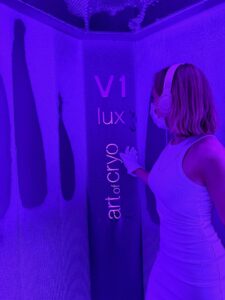
Chapter 7: Cryotherapy for Beauty and Skin Care: A Cool Approach to Radiance
The pursuit of youthful, radiant skin has been a timeless endeavor, and people have explored various treatments and remedies to achieve this goal. Cryotherapy, with its ability to rejuvenate the skin and promote a healthy glow, has emerged as a refreshing and innovative approach to beauty and skincare. In this chapter, we’ll explore how cryotherapy can be a cool solution for enhancing your beauty regimen.
1. Cryotherapy Facials
Cryotherapy facials have gained popularity as a non-invasive and natural way to revitalize the skin. During a cryo facial, a specialized wand or device emits extremely cold air onto the face, neck, and decolletage. This cold exposure stimulates blood flow, tightens the skin, and reduces puffiness. Many individuals find that cryo facials leave their skin looking and feeling refreshed.
2. Collagen Production
Collagen is a crucial protein for skin health, responsible for maintaining its elasticity and firmness. As we age, collagen production naturally decreases, leading to wrinkles and sagging skin. Cryotherapy can help boost collagen production by triggering the body’s natural healing mechanisms. The cold exposure encourages the production of collagen, which can lead to smoother and more youthful-looking skin.
3. Reduced Pore Size
Cryotherapy’s skin-tightening effects can also reduce the appearance of enlarged pores. Cold exposure causes blood vessels to constrict, which tightens the skin and minimizes the appearance of pores. This can result in a smoother complexion and a more even skin texture.
4. Skin Rejuvenation
For those looking to rejuvenate their skin and reduce the signs of aging, cryotherapy offers a refreshing solution. Regular cryotherapy sessions can help maintain a youthful glow by improving skin tone and reducing the appearance of fine lines and wrinkles.
5. Acne Management
Acne is a common skin concern that affects people of all ages. Cryotherapy has shown promise in managing acne by reducing inflammation and minimizing the size of acne lesions. Some individuals find that localized cryotherapy treatments can help speed up the healing process and prevent scarring.
6. Skin Conditions
Cryotherapy has been explored as a complementary therapy for various skin conditions, including psoriasis and eczema. While it may not be a cure, cryotherapy can provide relief by reducing itching and inflammation associated with these conditions. It’s essential to consult with a dermatologist before using cryotherapy for skin conditions.
7. Vibrant Complexion
The increase in blood flow and circulation during and after cryotherapy can give the skin a rosy and vibrant complexion. Many individuals report that their skin looks healthier and more radiant after cryotherapy sessions, making it a popular choice before special events or occasions.
8. Enhanced Product Absorption
Cryotherapy can also improve the absorption of skincare products. When the skin is exposed to cold, it tightens, which can temporarily reduce pore size. Smaller pores can mean better absorption of serums, moisturizers, and other skincare products, making them more effective.
9. Stress Reduction
Stress is a common factor that can negatively impact skin health. The relaxing and mood-enhancing effects of cryotherapy can indirectly benefit the skin. Reduced stress levels can lead to improved skin health, as stress is known to exacerbate certain skin conditions.
10. Personalized Beauty Regimen
Cryotherapy can be integrated into your personalized beauty regimen to complement other skincare practices. Whether you’re looking to improve skin texture, reduce the signs of aging, or manage specific skin concerns, cryotherapy offers a versatile and refreshing addition to your beauty routine.
Conclusion
Cryotherapy is not just about enhancing physical performance or managing pain; it’s also a powerful tool for promoting beauty and skincare. Its ability to stimulate collagen production, reduce the appearance of pores, and rejuvenate the skin has made it a favorite among those seeking a cool and refreshing approach to radiant skin. As we continue our exploration of cryotherapy in the following chapters, we will delve deeper into its applications in mental well-being, overall health, and more, providing a comprehensive understanding of its versatile potential.

Chapter 8: Cryotherapy and Mental Well-Being: The Chilling Effect on Stress and Mood
In today’s fast-paced and often stressful world, the pursuit of mental well-being has become increasingly important. Stress, anxiety, and mood disorders can take a toll on one’s quality of life. While cryotherapy is primarily known for its physical benefits, it also offers a chilling effect on stress and mood. In this chapter, we’ll explore how cryotherapy can contribute to a calmer and more balanced state of mind.
1. Stress Reduction
Stress is a common and pervasive issue that can have detrimental effects on both physical and mental health. Cryotherapy’s ability to trigger the release of endorphins, those feel-good hormones, can help combat stress. Many individuals find that a cryotherapy session provides immediate relief from stress and tension, leaving them feeling more relaxed and at ease.
2. Mood Enhancement
Cryotherapy’s mood-enhancing effects go beyond stress reduction. The rush of endorphins during and after a cryotherapy session can elevate mood and enhance overall well-being. It’s not uncommon for individuals to report feeling more positive, optimistic, and mentally resilient following cryotherapy.
3. Improved Sleep
Quality sleep is essential for mental health and overall well-being. Stress and anxiety can disrupt sleep patterns, leading to insomnia or poor sleep quality. Cryotherapy’s relaxing effects and reduction in stress can contribute to better sleep. Many individuals who incorporate cryotherapy into their routines report improved sleep patterns and more restful nights.
4. Anxiety Management
Anxiety disorders, which affect millions of people worldwide, can be challenging to manage. While cryotherapy is not a replacement for professional treatment, some individuals with anxiety disorders have reported relief from symptoms after cryotherapy sessions. The calming and mood-enhancing effects of cryotherapy can help individuals cope with anxiety more effectively.
5. Enhanced Focus and Mental Clarity
Many people turn to cryotherapy as a way to boost mental clarity and focus. The increased circulation and oxygenation of the brain during and after a cryotherapy session can lead to improved cognitive function. This can be particularly beneficial for individuals looking to enhance their productivity and mental performance.
6. Mind-Body Connection
Cryotherapy encourages a mind-body connection by promoting relaxation and mindfulness. As individuals immerse themselves in the cold environment, they often engage in deep breathing exercises and focused relaxation techniques. This mindfulness can help individuals better manage stress and anxiety in their daily lives.
7. Mental Resilience
The ability to bounce back from challenges and setbacks is a crucial aspect of mental resilience. Cryotherapy’s mood-enhancing effects can contribute to greater mental resilience, helping individuals navigate life’s ups and downs with a more positive outlook.
8. Holistic Well-Being
Cryotherapy’s impact on mental well-being is part of its holistic approach to health and wellness. It recognizes that physical and mental health are interconnected, and by addressing one aspect, such as stress reduction, it can have positive ripple effects on overall well-being.
9. Integrative Approach
Many individuals incorporate cryotherapy into their broader mental health and wellness routines. It can complement other practices such as meditation, mindfulness, therapy, and exercise. The synergy between cryotherapy and these practices can contribute to a more balanced and mentally healthy lifestyle.
10. Self-Care and Self-Reflection
Cryotherapy sessions often provide individuals with a quiet and reflective space. As they step into the cold chamber or receive localized cryotherapy, they have the opportunity for self-care and self-reflection. This introspective time can be valuable for processing emotions and gaining insight into one’s mental well-being.
Conclusion
Cryotherapy’s effects on mental well-being, including stress reduction, mood enhancement, and improved sleep, make it a valuable addition to the toolkit of those seeking a balanced and emotionally healthy life. While it is not a replacement for professional mental health treatment when needed, cryotherapy offers a refreshing and holistic approach to supporting mental well-being. In the following chapters, we will continue to explore cryotherapy’s applications in overall health, performance optimization, and more, providing a comprehensive understanding of its versatile potential.

Chapter 9: Cryotherapy for Overall Health: Chilling Path to Wellness
Cryotherapy, with its ability to enhance physical recovery, improve mental well-being, and offer a range of other benefits, has earned its place as a holistic approach to overall health and wellness. In this chapter, we will explore how cryotherapy contributes to a comprehensive path to well-being.
1. Enhanced Circulation
One of the key physiological responses to cryotherapy is enhanced circulation. As the body is exposed to cold temperatures, blood vessels constrict and then dilate after the cold exposure, leading to improved circulation. This increased blood flow can benefit various aspects of health, including cardiovascular health.
2. Immune System Boost
Cryotherapy has been associated with immune system enhancement. Exposure to cold temperatures prompts the body to produce more white blood cells, which play a vital role in fighting infections. A stronger immune system can help individuals ward off illnesses more effectively.
3. Reduced Inflammation
Inflammation is at the root of many chronic diseases and health conditions. Cryotherapy’s ability to reduce inflammation can be beneficial for individuals dealing with conditions like arthritis, autoimmune disorders, and chronic pain. By bringing inflammation under control, cryotherapy contributes to better overall health.
4. Weight Management Support
While not a standalone solution for weight management, cryotherapy has been explored as a potential aid. The temporary increase in metabolism during and after cryotherapy sessions can lead to the burning of more calories. Additionally, some individuals find that cryotherapy helps reduce food cravings, making it a practical tool in their weight loss journey.
5. Pain Management for Chronic Conditions
Chronic pain conditions, such as fibromyalgia, neuropathy, and arthritis, can significantly impact one’s quality of life. Cryotherapy offers a non-pharmacological and non-invasive approach to pain management for individuals dealing with chronic pain. By reducing pain and inflammation, cryotherapy can improve overall comfort and well-being.
6. Hormone Regulation
Cryotherapy has been linked to improved hormone regulation. The release of endorphins during and after cryotherapy sessions can help balance hormones associated with mood and stress, contributing to a more stable emotional state.
7. Skin Health
Healthy skin is not just about appearance; it’s also a reflection of overall health. Cryotherapy facials and treatments can rejuvenate the skin, improve its texture, and promote a youthful glow. Skin health is often an indicator of well-being, and cryotherapy can enhance it from the inside out.
8. Quality Sleep
Sleep is a cornerstone of overall health and wellness. Stress and anxiety can disrupt sleep patterns, leading to insomnia or poor sleep quality. Cryotherapy’s relaxation and mood-enhancing effects can contribute to better sleep, allowing individuals to wake up refreshed and energized.
9. Holistic Wellness Approach
Cryotherapy’s impact on overall health is part of its holistic approach to well-being. It recognizes that health is interconnected, and by addressing various aspects, such as circulation, inflammation, and immune function, it promotes a more balanced and comprehensive approach to wellness.
10. Integrative Lifestyle
Many individuals incorporate cryotherapy into their integrative wellness routines. It complements other practices such as exercise, a balanced diet, mindfulness, and meditation. The synergy between cryotherapy and these wellness practices can enhance overall health and promote a more vibrant and fulfilling life.
Conclusion
Cryotherapy’s multifaceted approach to well-being, encompassing physical, mental, and overall health, has made it a valuable tool for those seeking a path to wellness. Whether you’re looking to enhance physical recovery, improve mental resilience, manage chronic conditions, or simply elevate your quality of life, cryotherapy offers a chilling but refreshing journey toward holistic wellness. In the following chapters, we will continue to explore cryotherapy’s applications in performance optimization, recovery, and more, providing a comprehensive understanding of its versatile potential.

Chapter 10: Cryotherapy in Practice: How to Incorporate Cryotherapy Into Your Routine
You’ve learned about the numerous benefits of cryotherapy for physical recovery, mental well-being, and overall health. Now, it’s time to explore how you can incorporate cryotherapy into your routine effectively. In this chapter, we’ll discuss practical considerations and tips for making cryotherapy a part of your lifestyle.
1. Finding a Cryotherapy Facility
The first step in incorporating cryotherapy into your routine is to find a reputable cryotherapy facility near you. These facilities offer various cryotherapy modalities, including whole-body cryo chambers, localized treatments, and cryo facials. Use online search engines, directories, and reviews to locate a facility with positive feedback and experienced staff.
2. Consultation and Medical History
Once you’ve identified a facility, schedule a consultation. During this consultation, you’ll discuss your goals, health history, and any concerns with a trained professional. It’s crucial to provide accurate information about your health and any pre-existing medical conditions to ensure safe and effective cryotherapy sessions.
3. Customized Treatment Plan
Based on your consultation and goals, the facility will create a customized treatment plan. This plan may include recommendations for the frequency and duration of cryotherapy sessions. Be sure to ask any questions you have and communicate your preferences and concerns.
4. Dress Appropriately
When preparing for a cryotherapy session, it’s essential to dress appropriately. You’ll typically be provided with specialized cryotherapy attire, including gloves, socks, and footwear. Remove any jewelry or metal objects from your body to prevent discomfort during the session.
5. Hydration and Nutrition
Staying hydrated is crucial before and after a cryotherapy session. Cold exposure can cause the body to lose fluids, so drink water to ensure you’re adequately hydrated. Additionally, consider having a light meal or snack before your session to maintain energy levels.
6. During the Session
During a cryotherapy session, you’ll experience cold exposure, and it’s essential to follow the facility’s guidelines and instructions. Focus on relaxation techniques, such as deep breathing and mindfulness, to help manage the cold sensation. Some facilities offer distractions like music or video screens to keep your mind engaged.
7. Post-Session Care
After a cryotherapy session, your body will continue to benefit from the effects. Take a few moments to relax and allow your body to warm up naturally. Engaging in light movement or stretching can help promote circulation and recovery.
8. Consistency is Key
To maximize the benefits of cryotherapy, consistency is key. Depending on your goals and treatment plan, you may need to schedule regular sessions. Consistent cryotherapy can lead to cumulative effects, such as improved recovery, reduced pain, and enhanced overall well-being.
9. Combine with Other Wellness Practices
Cryotherapy can complement other wellness practices effectively. Consider integrating cryotherapy into your existing wellness routine, which may include exercise, meditation, a balanced diet, and stress management techniques. The synergy between cryotherapy and these practices can enhance your overall health and well-being.
10. Listen to Your Body
Lastly, it’s crucial to listen to your body. Pay attention to how you feel before, during, and after cryotherapy sessions. If you experience any discomfort or adverse effects, discuss them with the facility’s staff. Your well-being should always be the top priority.
Conclusion
Incorporating cryotherapy into your routine can be a transformative journey toward better physical and mental health. By finding a reputable facility, customizing your treatment plan, and following best practices, you can make cryotherapy a valuable part of your lifestyle. Remember that cryotherapy is just one tool in your wellness arsenal, and its effects can be amplified when combined with other healthy practices. As you embark on this chilling path to well-being, you’ll discover the numerous benefits that cryotherapy has to offer.
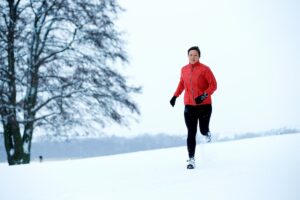
Chapter 11: Cryotherapy and the Future: Emerging Trends and Possibilities
As we’ve journeyed through the world of cryotherapy, exploring its myriad applications in physical recovery, mental well-being, overall health, and wellness, it’s clear that cryotherapy is more than just a passing trend. In this chapter, we’ll delve into the future of cryotherapy, examining emerging trends and exciting possibilities on the horizon.
1. Personalized Cryotherapy
One of the emerging trends in cryotherapy is personalized treatments. As technology advances, cryotherapy facilities are exploring ways to tailor sessions to individual needs. This could involve adjusting temperature levels, treatment durations, and targeted areas, allowing for more precise and effective cryotherapy experiences.
2. Home Cryotherapy Devices
While cryotherapy has traditionally been administered in specialized facilities, there’s growing interest in home cryotherapy devices. These compact machines offer convenience and accessibility, enabling individuals to enjoy cryotherapy sessions in the comfort of their homes. As technology improves, we can expect more user-friendly and effective home devices to enter the market.
3. Cryotherapy and Virtual Reality (VR)
To enhance the cryotherapy experience, some facilities are integrating virtual reality (VR). During a cryotherapy session, individuals can immerse themselves in calming VR environments, creating a multisensory and relaxing experience. This innovative fusion of technology and wellness may become more prevalent in the future.
4. Cryotherapy in Professional Sports
Professional sports teams and athletes are increasingly recognizing the benefits of cryotherapy for performance optimization and recovery. As cryotherapy continues to demonstrate its efficacy in this domain, we can expect more sports organizations to invest in cryotherapy chambers and treatments as standard practice.
5. Cryotherapy and Longevity
Interest in longevity and aging gracefully has prompted research into the potential anti-aging effects of cryotherapy. Some studies suggest that cryotherapy may contribute to cellular rejuvenation and extended longevity. While the science is still evolving, this area holds exciting possibilities for the future.
6. Cryotherapy and Mental Health
Mental health awareness is growing, and cryotherapy’s positive effects on mood and stress reduction are gaining attention. In the future, we may see cryotherapy integrated into mental health and wellness programs as a complementary therapy for conditions like anxiety and depression.
7. Cryotherapy for Chronic Disease Management
Research into cryotherapy’s impact on chronic diseases, such as diabetes and multiple sclerosis, is ongoing. While it’s not a cure, cryotherapy may offer relief from certain symptoms and contribute to better disease management. As more studies are conducted, we may uncover new applications for cryotherapy in chronic disease care.
8. Cryotherapy for Space Travel
In the realm of space exploration, cryotherapy is being explored as a means to mitigate the effects of long-term space travel on the human body. Extreme cold exposure can counteract muscle and bone loss experienced by astronauts during extended missions. Cryotherapy chambers aboard spacecraft could become a standard feature in the future.
9. Cryotherapy and Cryonics
Cryonics, the practice of preserving human bodies at low temperatures after legal death in the hope of future revival, is a controversial but fascinating field. Cryotherapy technology and research may play a role in advancing the science of cryonics, potentially opening new frontiers in the quest for immortality.
10. Ethical and Regulatory Considerations
As cryotherapy evolves and diversifies, ethical and regulatory considerations will become increasingly important. Ensuring the safety and ethical use of cryotherapy in various applications will be a critical aspect of its future development.
Conclusion
Cryotherapy is poised to continue its transformative journey into the future, with emerging trends and exciting possibilities on the horizon. From personalized treatments to home devices, from mental health applications to space travel, the potential for cryotherapy is vast and inspiring. As science and technology advance, cryotherapy’s role in enhancing physical and mental well-being, extending longevity, and pushing the boundaries of human potential will continue to evolve. It’s an exciting time for cryotherapy enthusiasts and researchers alike as we look forward to the chilling adventures that await in the years to come.

Chapter 12: Cryotherapy Around the World: International Trends
Cryotherapy, with its diverse applications and benefits, has gained popularity not only in its country of origin, Japan but also across the globe. As we explore international trends in cryotherapy, we’ll discover how this innovative wellness practice has found its place in different cultures and lifestyles.
1. Japan – The Birthplace of Whole-Body Cryotherapy
Cryotherapy originated in Japan in the late 1970s when Dr. Toshima Yamaguchi developed the first whole-body cryotherapy chamber. Today, Japan remains a hub for cryotherapy research and innovation. Japanese facilities are known for their cutting-edge technology and strict safety standards.
2. Europe – Wellness Capitals
Europe has embraced cryotherapy as a vital part of the wellness industry. Countries like Germany, Poland, and France have witnessed significant growth in cryotherapy facilities. Europeans are incorporating cryotherapy into their health and wellness routines, valuing its potential for muscle recovery, skin rejuvenation, and stress reduction.
3. United States – Expanding Beyond Athletes
In the United States, cryotherapy initially gained popularity among professional athletes and sports enthusiasts. However, it has now expanded to a broader audience, including individuals seeking relief from chronic pain and those interested in beauty and anti-aging treatments. The U.S. remains a significant player in the cryotherapy market.
4. Russia – Cold Plunges and Sauna Combinations
In Russia, a nation known for its love of saunas and cold plunges, cryotherapy has found a natural home. Many Russians combine cryotherapy sessions with traditional sauna experiences, believing that the combination enhances the benefits of both practices.
5. Australia – Wellness Down Under
Australia’s wellness industry has welcomed cryotherapy as a holistic approach to health and vitality. With a focus on physical recovery, cryotherapy has become popular among fitness enthusiasts and those looking to relieve muscle soreness.
6. South Korea – Beauty and Anti-Aging Focus
South Korea, renowned for its beauty and skincare innovations, has incorporated cryotherapy into its beauty and anti-aging routines. Cryotherapy facials and localized treatments are gaining traction among those seeking youthful and radiant skin.
7. Middle East – Wellness in Luxury
In the Middle East, particularly in countries like the UAE, Qatar, and Saudi Arabia, luxury wellness centers have introduced cryotherapy as part of their premium services. It’s seen as a way to enhance physical well-being and cope with the demands of a fast-paced lifestyle.
8. Latin America – Wellness Tourism
Latin American countries, including Mexico and Brazil, have seen a rise in wellness tourism. Cryotherapy is being offered as an attraction in wellness resorts and retreats, appealing to travelers looking for unique experiences that prioritize health and relaxation.
9. Asia – A Growing Market
Asian countries like China and South Korea have been witnessing the growth of cryotherapy as wellness awareness spreads. The potential benefits for physical recovery and beauty enhancement align with the wellness aspirations of many Asians.
10. The Global Future
Cryotherapy’s global expansion shows no signs of slowing down. As more research emerges, and as technology continues to advance, we can expect cryotherapy to become even more accessible and diverse in its applications. It’s likely that new trends and adaptations will continue to emerge, making cryotherapy a truly international wellness phenomenon.
Conclusion
Cryotherapy’s journey from its inception in Japan to its widespread adoption around the world reflects its versatility and appeal across cultures and lifestyles. Whether used for physical recovery, beauty enhancement, or overall wellness, cryotherapy has established its place as a global trend in the pursuit of health and vitality. As we look ahead, we can anticipate further international integration and adaptation of this innovative wellness practice.

Chapter 13: DIY Cryotherapy: At-Home Techniques and Safety
While many people prefer to experience cryotherapy at specialized facilities, there is a growing interest in DIY (Do-It-Yourself) cryotherapy techniques that can be done at home. In this chapter, we’ll explore various at-home cryotherapy methods and essential safety considerations to ensure a safe and effective experience.
1. Cold Showers and Baths
One of the simplest DIY cryotherapy techniques is taking cold showers or baths. The exposure to cold water can stimulate circulation, reduce inflammation, and promote mental alertness. Start with warm water and gradually transition to cold, allowing your body to acclimate.
Safety Tip: Be cautious not to make the water too cold, as extreme cold exposure can lead to discomfort or even hypothermia. Monitor your body’s response and limit cold exposure to a few minutes.
2. Ice Packs and Cold Compresses
Ice packs or cold compresses can be applied to specific areas of the body to target pain, swelling, or inflammation. These are particularly effective for localized cryotherapy. Ensure you wrap the ice pack in a thin cloth to avoid direct skin contact, which can cause frostbite.
Safety Tip: Limit the application of ice packs to 15-20 minutes at a time, allowing the skin to warm up between sessions to prevent cold injuries.
3. Cold Water Immersion
If you have access to a cold body of water, such as a lake or a pool, cold water immersion can be an effective DIY cryotherapy method. Submerging the body in cold water can help reduce muscle soreness and promote recovery.
Safety Tip: Always exercise caution when immersing yourself in cold water, especially if you are not accustomed to it. Start with short durations and gradually increase the time spent in cold water.
4. Cryotherapy Facials at Home
To enjoy the beauty and skincare benefits of cryotherapy at home, consider cryotherapy facials. You can use specialized cryo globes or facial rollers designed for cold therapy. Gently massage your face and neck with the cold tools to promote circulation and rejuvenate the skin.
Safety Tip: Ensure the facial tools are properly sanitized before use to prevent skin irritation or infection.
5. Cold Packs for Inflammation
For targeted inflammation relief, you can create DIY cold packs using household items. Fill a sealable plastic bag with crushed ice or frozen vegetables and wrap it in a thin cloth. Apply the cold pack to the affected area for short intervals.
Safety Tip: Always have a barrier, like a cloth, between the cold pack and your skin to avoid frostbite.
6. Cold Breathing Techniques
Some DIY cryotherapy enthusiasts practice cold breathing techniques to improve mental focus and increase cold tolerance. This involves controlled, deep breathing in a cold environment, such as taking a walk in cold weather while practicing focused breathing exercises.
Safety Tip: Be aware of your body’s response, and if you start to feel extremely cold or experience discomfort, return to a warmer environment.
7. Cold Space or Room
Creating a cold space or room at home is another DIY option. You can use fans, open windows, or air conditioning to lower the room’s temperature. Spending time in a cold room can provide some of the benefits of whole-body cryotherapy.
Safety Tip: Ensure you don’t make the room too cold, and always have a warm space nearby to retreat to if needed.
8. Safety Considerations
When practicing DIY cryotherapy at home, it’s crucial to prioritize safety:
- Start Slowly: If you’re new to cold exposure, start with shorter durations and gradually increase them as your body adapts.
- Monitor Your Body: Pay close attention to how your body responds. If you experience severe discomfort, numbness, or shivering, it’s time to warm up.
- Stay Hydrated: Cold exposure can lead to increased fluid loss through respiration and sweating. Stay adequately hydrated before and after cryotherapy sessions.
- Consult a Professional: If you have any underlying medical conditions or concerns, consult a healthcare professional before attempting DIY cryotherapy.
Conclusion
DIY cryotherapy can offer some of the benefits of professional cryotherapy sessions from the comfort of your home. However, it’s essential to approach DIY cryotherapy with caution, prioritize safety, and be mindful of your body’s response to cold exposure. When practiced responsibly, DIY cryotherapy can be a valuable addition to your wellness routine.

Chapter 14: The Future of Cryotherapy: Innovations on the Horizon
As we continue to explore the fascinating world of cryotherapy, it’s evident that this field is ripe for innovation. In this chapter, we’ll delve into the exciting innovations and technologies on the horizon, painting a picture of what the future of cryotherapy may look like.
1. AI-Powered Personalization
The future of cryotherapy may involve AI-powered personalization. Imagine a cryotherapy session tailored to your unique physiology and needs. AI algorithms could analyze data from sensors, such as skin temperature and heart rate, to adjust the cold exposure duration and intensity for maximum benefits while ensuring safety.
2. Cryotherapy Wearables
Cryotherapy wearables could become a reality, allowing individuals to experience the benefits of cold exposure throughout the day. These wearable devices may provide localized cryotherapy for specific areas of the body, such as sore muscles or joints, delivering therapeutic cold therapy discreetly and conveniently.
3. Cryotherapy Pods for Home Use
While home cryotherapy machines exist, the future may see the development of compact cryotherapy pods designed for home use. These pods could offer whole-body cryotherapy experiences within the comfort of one’s residence, providing individuals with a convenient and consistent way to enjoy the benefits of cold therapy.
4. Cryotherapy in Telehealth
The integration of cryotherapy into telehealth services is another promising avenue. Virtual cryotherapy sessions, guided by healthcare professionals, could allow individuals to receive personalized cryotherapy treatments and advice remotely, expanding access to this wellness practice.
5. Cryotherapy for Cognitive Health
Research into cryotherapy’s effects on cognitive health is ongoing. In the future, we may see cryotherapy applications designed to enhance mental acuity and cognitive function. Cold exposure’s potential to stimulate brain activity may lead to innovative therapies for conditions like dementia and cognitive decline.
6. Cryotherapy and Genomics
The field of cryotherapy may intersect with genomics. Genetic profiling could help determine an individual’s optimal cold exposure regimen based on their genetic predispositions and health markers, leading to highly personalized cryotherapy treatments.
7. Cryotherapy for Chronic Disease Management
As the understanding of cryotherapy’s impact on chronic diseases deepens, it may become an integral part of chronic disease management. Cryotherapy treatments could be prescribed alongside traditional therapies to alleviate symptoms and improve the quality of life for individuals with chronic conditions.
8. Cryotherapy for Space Travel
In the context of space travel, cryotherapy chambers aboard spacecraft could become standard equipment. The ability to mitigate muscle and bone loss in astronauts during long missions could be essential for future space exploration endeavors.
9. Cryotherapy and Immune Health
The connection between cryotherapy and immune health is an area of active research. Innovations may lead to cryotherapy protocols specifically designed to boost immune function, making it a valuable tool in preventing and managing infections.
10. Cryotherapy in Integrative Medicine
Cryotherapy may play a more prominent role in integrative medicine, where traditional and complementary therapies are combined for holistic care. Integrative health centers may incorporate cryotherapy as a standard offering for patients seeking comprehensive wellness.
11. Ethical Considerations and Regulation
As cryotherapy evolves, ethical considerations and regulation will become increasingly important. Ensuring that cryotherapy innovations prioritize safety, access, and ethical use will be crucial for the industry’s growth and credibility.
Conclusion
The future of cryotherapy is a landscape of endless possibilities, where science, technology, and innovation converge to unlock the full potential of cold therapy. From AI-powered personalization to cryotherapy wearables, telehealth integration, and advancements in cognitive health and genomics, the cryotherapy field is poised for a transformative journey. As researchers, engineers, and healthcare professionals continue to push the boundaries of what’s possible, we can look forward to a future where cryotherapy plays an even more significant role in enhancing our physical, mental, and overall well-being. The chilling adventures in cryotherapy are far from over, and the best is yet to come.
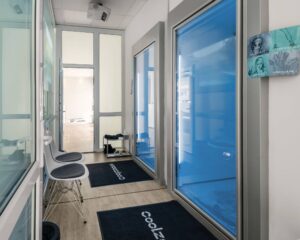
Chapter 15: Real People, Real Stories: Cryotherapy Testimonials
Throughout our exploration of cryotherapy, we’ve learned about its numerous benefits, applications, and potential future innovations. However, the true testament to the power of cryotherapy lies in the experiences and testimonials of real people who have incorporated it into their lives. In this chapter, we’ll share some compelling cryotherapy testimonials that highlight the real-world impact of this innovative wellness practice.
Testimonial 1: John’s Journey to Recovery
John, a dedicated athlete, had been struggling with persistent muscle soreness and fatigue after intense training sessions. He decided to try cryotherapy at a local facility after hearing about its potential benefits for recovery. In his words:
“Cryotherapy has been a game-changer for me. After each session, I feel refreshed and ready to tackle my next workout. The reduction in muscle soreness is incredible, and it has allowed me to push my limits in training like never before. It’s not just a physical boost; it’s a mental one too.”
Testimonial 2: Sarah’s Battle with Chronic Pain
Sarah had been living with chronic pain due to an autoimmune condition for years. She had tried various treatments and medications with limited success. After consulting with her healthcare provider, she decided to incorporate cryotherapy into her pain management routine. She shared:
“I was skeptical at first, but cryotherapy has been a lifesaver. The relief from pain is remarkable, and I’ve been able to reduce my reliance on pain medications. It’s not a cure, but it has given me a new lease on life. I can now enjoy activities I thought were lost to me forever.”
Testimonial 3: Emily’s Journey to Mental Well-being
Emily had been experiencing high levels of stress and anxiety due to her demanding job. She sought natural ways to alleviate her symptoms and found cryotherapy. She described her experience:
“Cryotherapy has been a revelation for my mental health. The calming and mood-lifting effects are almost immediate. It’s become an essential part of my self-care routine, and I’ve seen a significant reduction in anxiety and stress. I’m more focused, resilient, and happier.”
Testimonial 4: Mark’s Recovery from an Injury
Mark, an avid runner, faced a setback when he suffered a knee injury during a marathon. Determined to recover quickly, he turned to cryotherapy as part of his rehabilitation plan. He shared his journey:
“Cryotherapy played a crucial role in my recovery. It helped reduce inflammation and pain in my injured knee, allowing me to start physical therapy sooner. The combination of cryotherapy, physical therapy, and determination got me back on the track faster than I ever expected.”
Testimonial 5: Jane’s Transformation in Beauty and Confidence
Jane had been looking for ways to rejuvenate her skin and boost her self-confidence. She decided to try cryotherapy facials after hearing about their potential benefits. She shared her experience:
“Cryotherapy facials have been a revelation for me. Not only has my skin texture improved, but I also feel more confident and radiant. It’s like a natural facelift that makes me look and feel younger. I can’t imagine my skincare routine without it now.”
Testimonial 6: David’s Journey to Weight Management
David had struggled with weight management for years, trying various diets and exercise routines. He incorporated cryotherapy into his fitness regimen and witnessed transformative results. He described his journey:
“Cryotherapy has been a game-changer for my weight management journey. It has helped me burn calories, control cravings, and stay motivated. The synergy between cryotherapy and my fitness routine has been the key to my success in shedding pounds and maintaining a healthy lifestyle.”
These real-life testimonials offer a glimpse into the diverse ways in which cryotherapy has positively impacted individuals’ lives. Whether it’s enhancing physical recovery, alleviating chronic pain, promoting mental well-being, accelerating injury rehabilitation, rejuvenating skin, or supporting weight management, cryotherapy has left a lasting imprint on the wellness journeys of countless people. As we conclude our exploration of cryotherapy, these stories remind us that the potential for transformation and well-being is real and attainable through the chilling adventures of cryotherapy.
